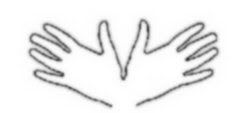How to Block
A successful block is when the ball rebounds of the hands of the blocker and directly back into the opponent's court or deflects of the hands in such a way that the blocker's team may play the ball. Blocking comes in two forms, single and multiple. A single block, where one person blocks the spike, is often not effective enough to stop a good spiker. The idea is to take away as much as the court possible from the spiker, leaving less of the court the blocker's team has to cover.
Difficulty: Easy
Time Required: It's up to you.
Here's How:
1. Set up - The most important factor is where you set up your block. Usually you want to be no more than one foot of the net and of course facing the opponent's. Keep you hands up at shoulder level and palms facing forward. Once the ball is set keep your eyes on the attacker. Position yourself on the attackers hitting arm, aligning half a body length to the side of the hitter's hitting arm.
2. Opponent Jumps First - Wait for the Attacker to Jump - Timing is key and you want to time your jump so that you jump immediately after the attacker jumps.
3. Reach - Reach your hands over the top of the net penetrating into the opponent's side of the net and positioned on both side of the attacker's hitting arm.
4. Angle Your Hands - You want to angle your hands slightly so that the ball will rebound off your hands and toward the middle of the opponent's court.
5. Recover - Whether or not you make contact with the ball, bring your hands back and land on two feet, bending your knees to cushion the landing.
6. Prepare - Immediately turn away from the net and look for the ball.
Tips:
1. Usually, time dictates whether your team will employ a double or single block. However, if time allows you should always put up a double block.
2. Another advantage to blocking is that by blocking the ball immediately back to the opponent's court this forces them to put up another attack. The longer that a team has the ball the more likely it is that they will make an unforced error.
3. Normally net contact errors are made on blocking because the blocker penetrates too much, resulting in hitting the net on the way up, or fails to withdraw his hands on the way down.
4. Inexperienced blockers will also set up too far from the net and actually jump forward to block the ball subsequently jumping into the net.
5. If you find that when blocking the ball the ball contacts your hands falls between you and the net, then you need to square your shoulders to the net more.
What You Need:
* Three friends
* A net
* A volleyball
Source: [url]http://www.volleyball.about.com[/u]



